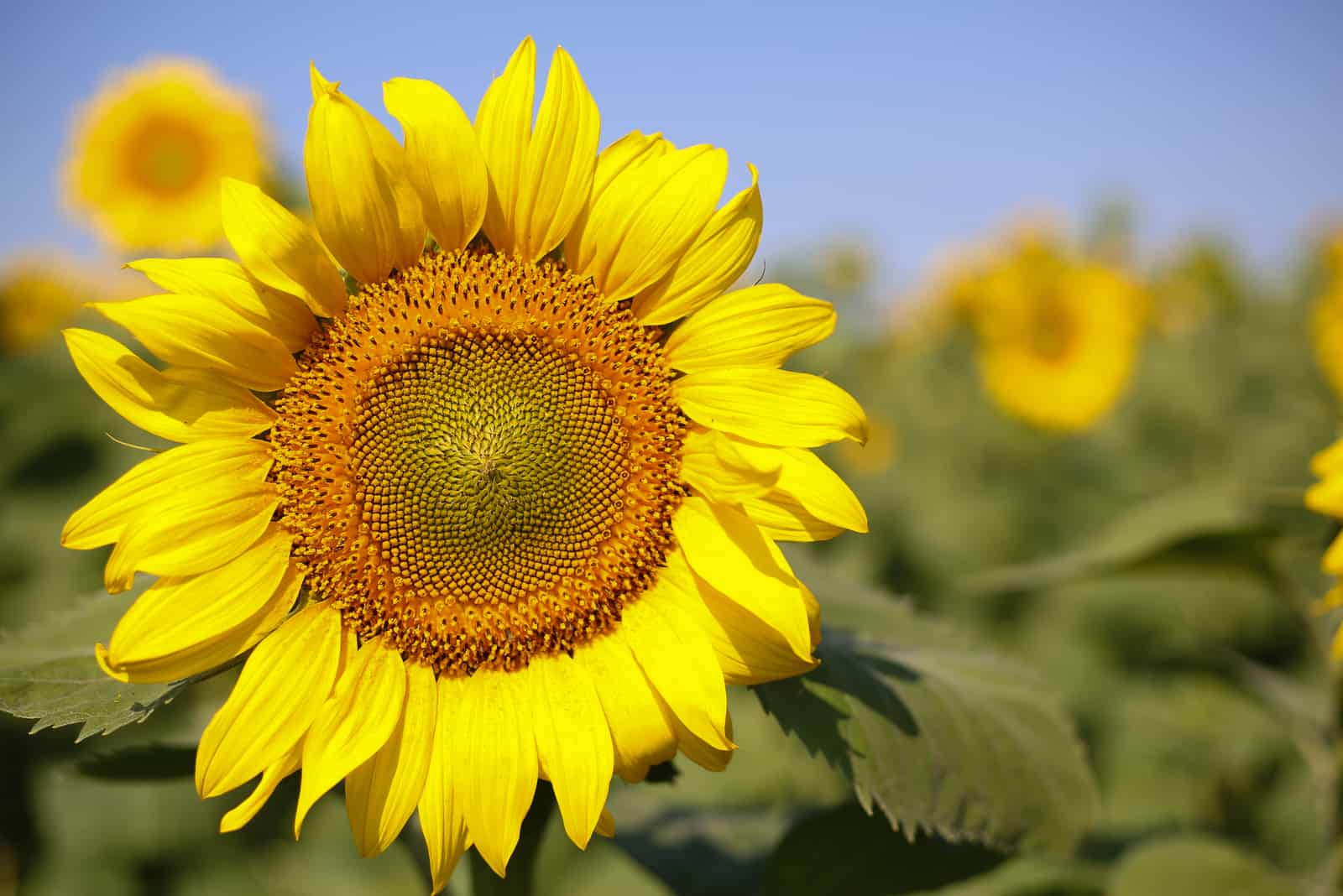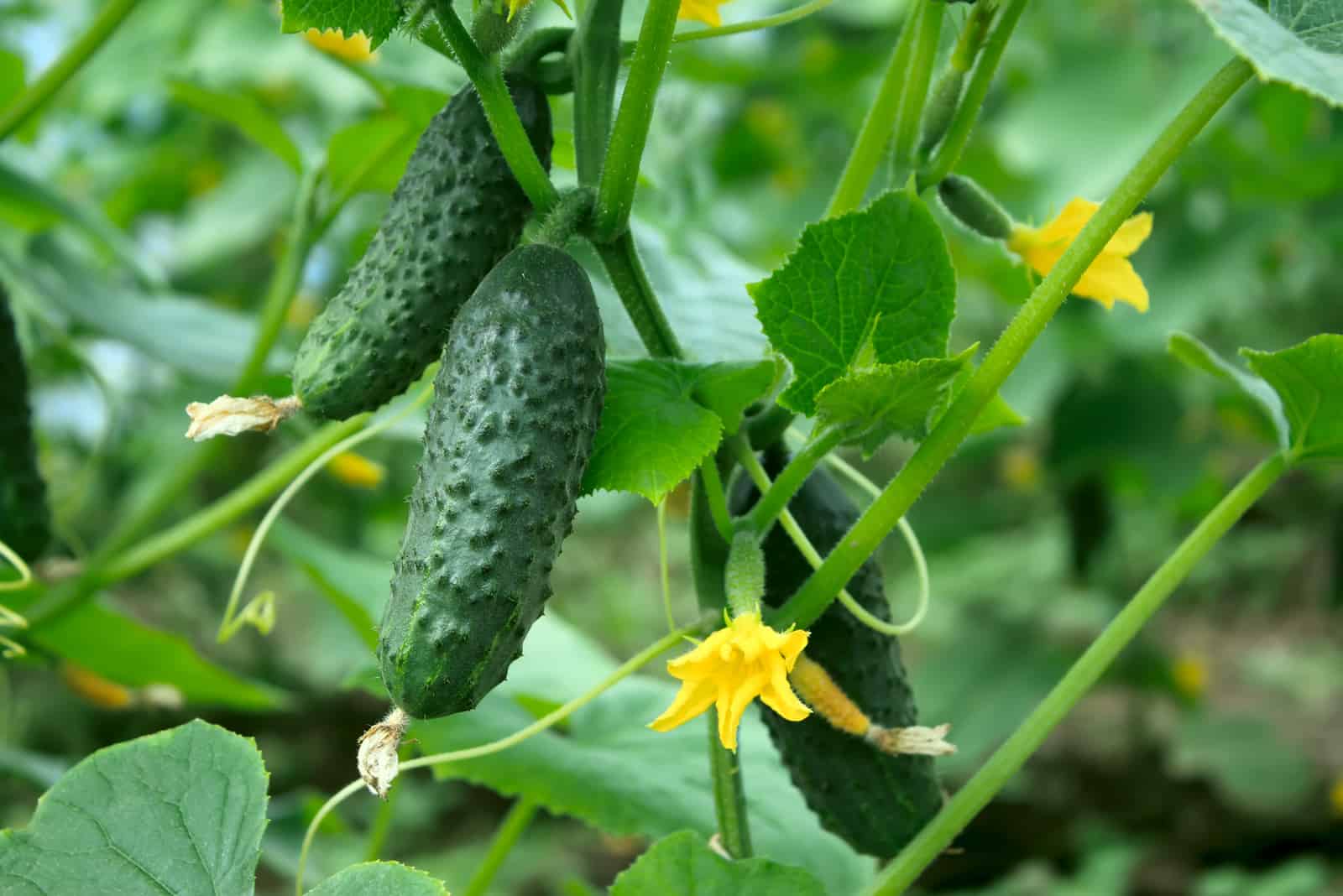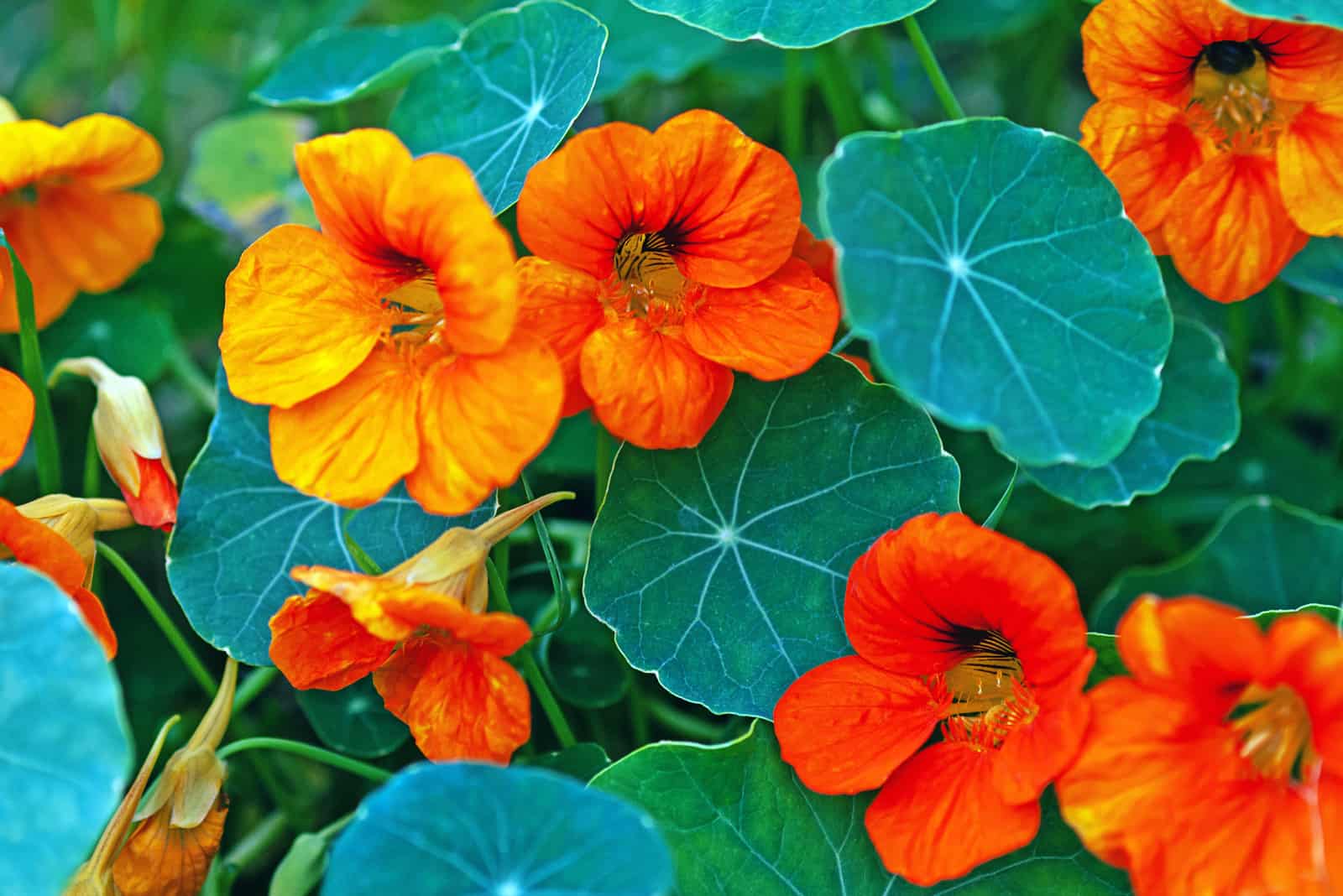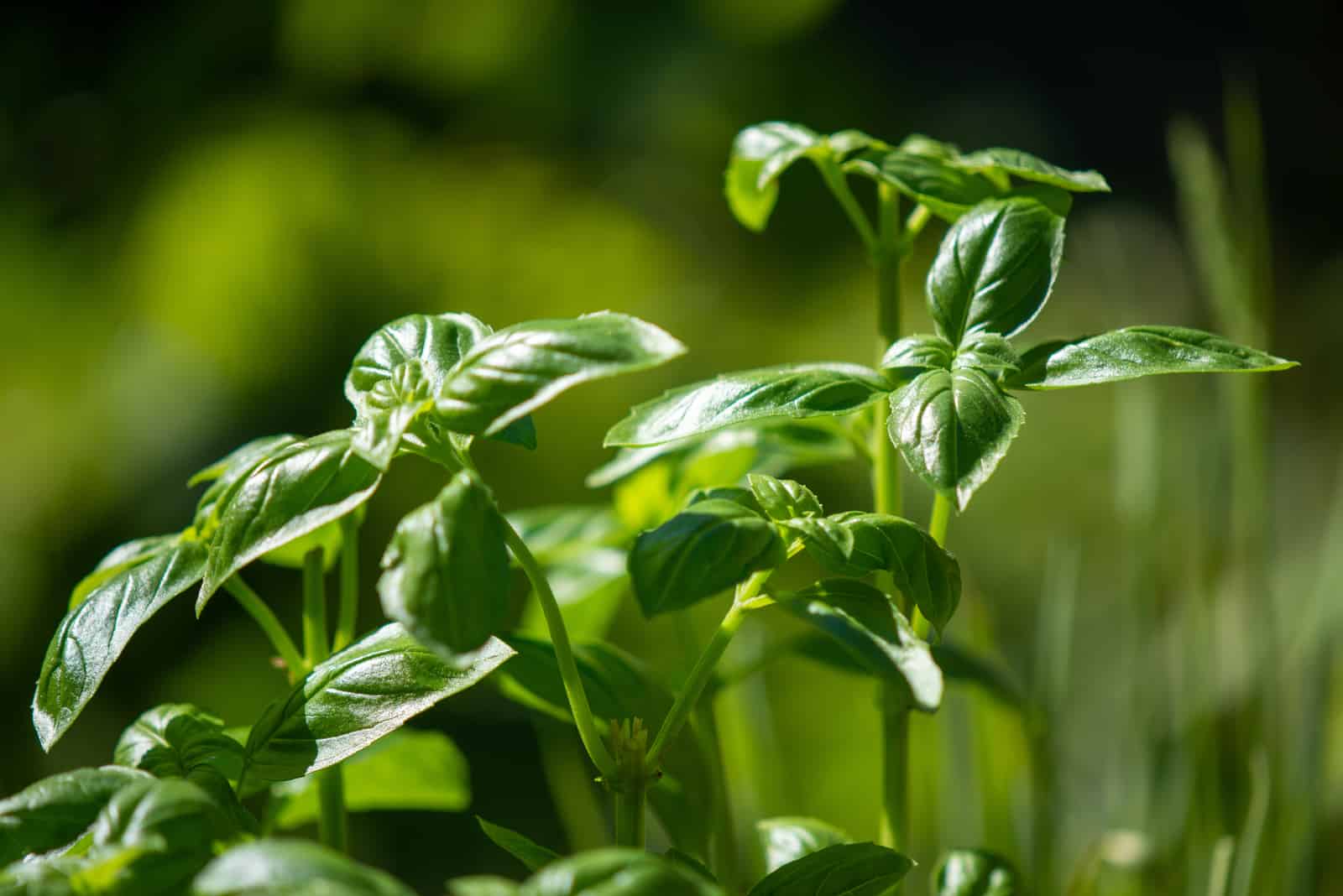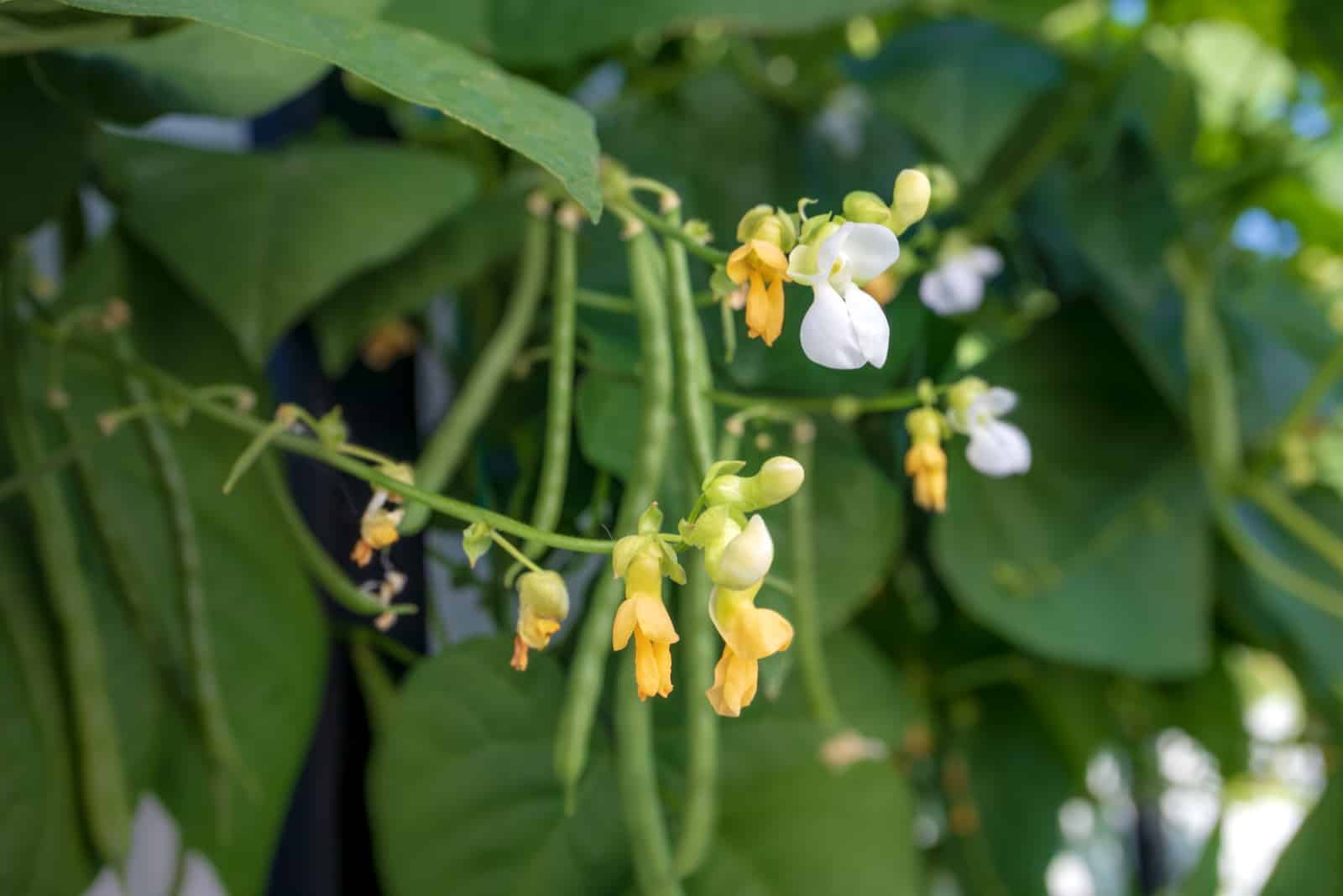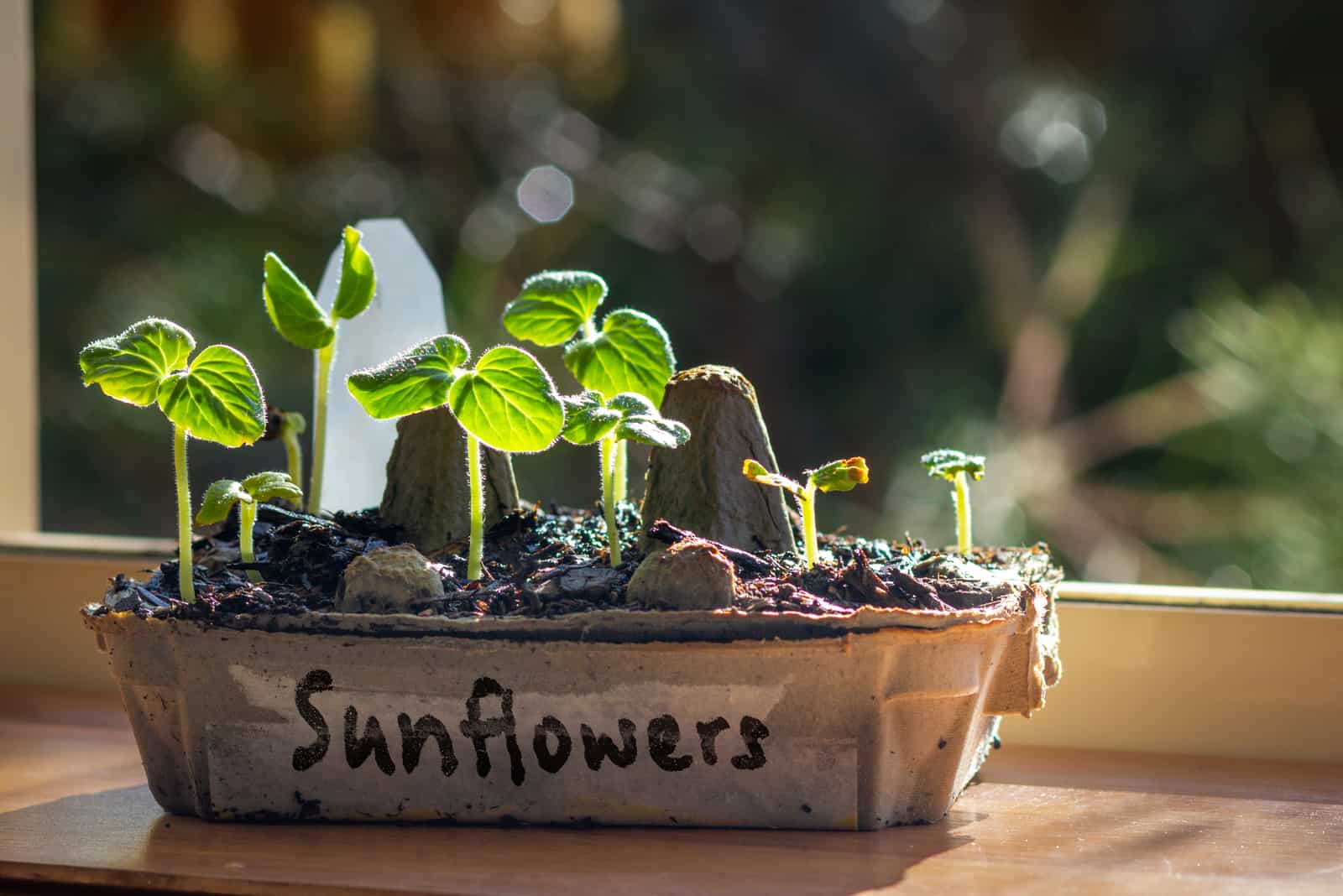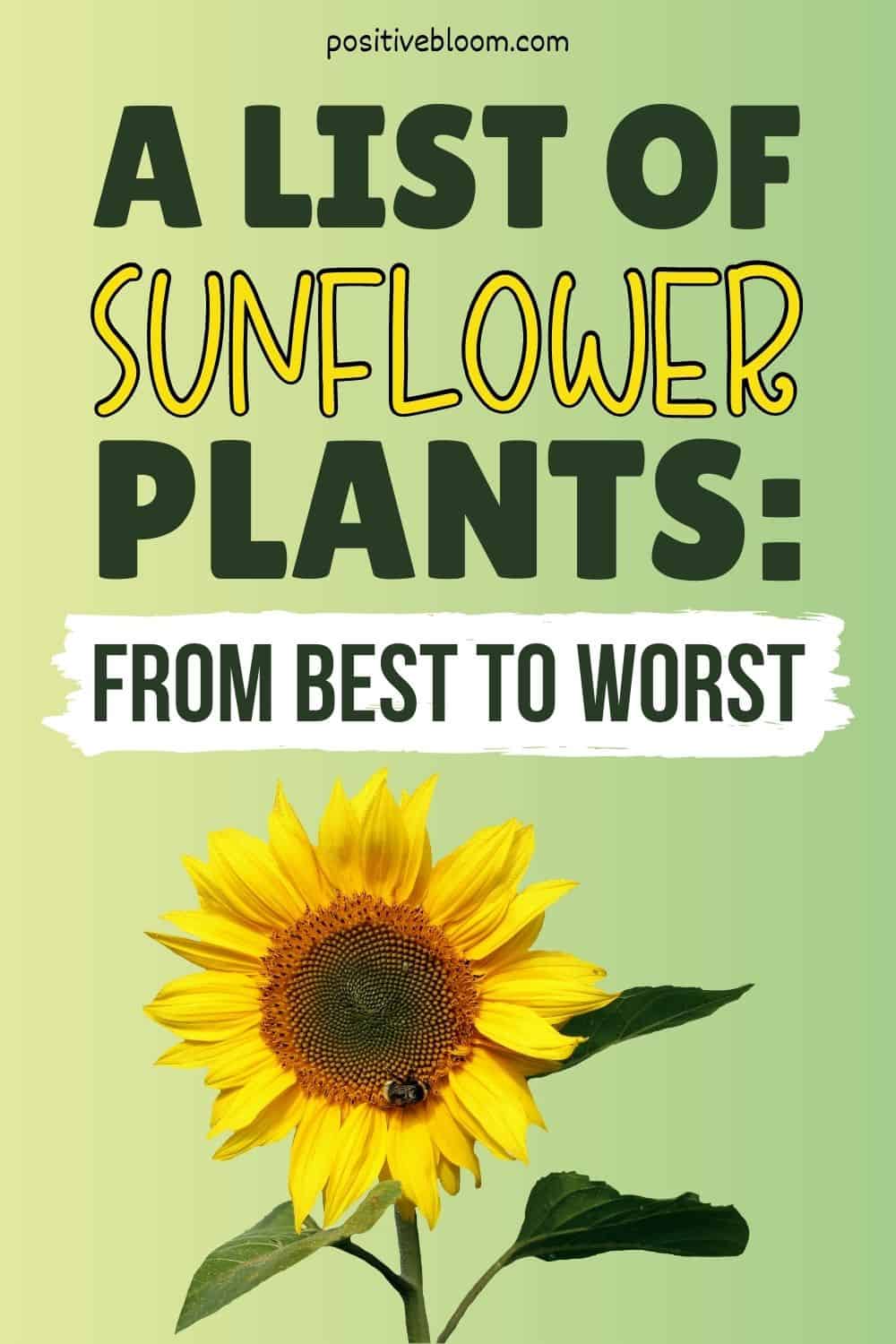Sunflowers (Helianthus annuus) are the plants that have it all: pest resistance, heat resistance, and of course, staggering beauty!
Additionally, they attract pollinators and birds, which makes them perfect for vegetable gardens.
Sunflowers seeds are even used to make oil; we benefit from sunflowers in so many ways.
When someone mentions sunflowers, we mostly think of the yellow ones, but they can come in various colors like orange, red, maroon, and brown.
Some may be only a foot tall, but there are records of 14 foot tall sunflowers!
They are heliotropic plants, which means that they turn their large flowers towards the sun.
If you want to grow healthy sunflowers, I suggest also growing some companion plants to accompany them. It’s beneficial in many ways; it helps deter pests, attract pollinators, and protect the sunflowers from wind (they really don’t like the wind).
I made a list of sunflower companion plants that will help your plant avoid these issues and grow healthy.
I also made a list of plants that shouldn’t be planted near Helianthus annuus.
Let’s take a look!
Sunflower Companion Plants: Vegetables
There are so many veggies that provide great company for sunflower plants.
Here’s a list of these veggies and some tips for growing them!
Cucumbers
Sunflowers get along well with cucumbers. The most significant benefit of planting cucumbers nearby is that they provide sturdy stems to climb on. On the other hand, the cucumber’s large leaves create partial shade for the soil, keeping it moist. Cucumber plants even reduce weeds. You can also add one more member of the Cucurbitaceae family, melons.
Great friends, right?!
Cucumbers thrive in full sun and prefer warmer temperatures. Before planting cucumber seeds, add compost or well-rotted manure to the soil to fertilize it.
They prefer porous and well-draining soil, so add peat, compost, and sand.
Plant cucumbers when the sunflowers are about 12 inches tall.
Radishes get along well with cucumbers, so consider planting them as well.
Lettuce
Lettuce is an easy to grow and great companion plant. This plant grows best in winter, so it needs shade to protect it from the full sun when grown in summer.
That’s why growing sunflowers next to lettuce is a great idea. If you add some natural repellent plants like onions and chives to this duo, you’ll have a garden that actively repels aphids.
Additionally, cucumbers will keep the soil cool for your sunflower and act as a mulch.
Lettuce requires moist and well-draining soil as it’s sensitive to overwatering.
These two plants are actually relatives as both belong to the Asteraceae (daisy) family.
Nasturtiums
The benefits of planting nasturtiums as companion plants include:
• They crawl over the ground to create shade and act as a cooling mulch. They also work great as groundcover.
• Suppress weeds.
• The nasturtium flowers attract pollinators such as butterflies and bees.
• The flowers also repel whiteflies and cucumber beetles.
• They are also known as trap crops because they draw pests and aphids away from other vegetables. They actually sacrifice themselves to save other plants, which makes them a friend indeed!
Nasturtiums have breathtaking flowers of various colors, such as orange, yellow, and red, which perfectly combine with sunflowers.
Nasturtiums prefer moist soil, but overwatering will reduce the number of flowers and change the taste.
Peppers
Peppers are susceptible to heat damage and benefit from being shaded by taller sunflowers. Aphids will avoid peppers if they are planted alongside Helianthus annuus.
Sunflowers not only supply nectar for beneficial insects that eat pests when they are in bloom, but their leaves also produce extrafloral nectar from the undersides of their leaves when they aren’t in bloom. This nectar is mainly produced for plant protection rather than pollination.
Beneficial insects are often drawn to the nectar and take care of the detrimental pests while they’re there.
Water your peppers with about 2 inches per week. However, this doesn’t mean shallow watering; peppers appreciate a good soaking, but they require a period of relative soil dryness between waterings.
The root system will grow stronger with slow and thorough watering. Underwatering will affect the yield and quality of the fruit. Pepper blossom-end rot is caused by inconsistent irrigation.
Sweet Corn
Corn may not seem like a good companion plant for sunflowers at first because both are pretty tall.
However, corn won’t take all the beneficial nutrients from the soil. Sunflowers attract beneficial insects like ladybugs, which eat the aphids, spider mites, and fruit flies that often affect corn.
Both plants produce substances that increase the yield of the other.
Thin immature corn plants (3-4 inches) to 8 to 12 inches apart.
Corn has shallow roots and can be affected by drought, so always keep it properly watered. Water it with around 2 inches per week, and bear in mind that the need for water increases if the weather is particularly hot or your soil is sandy.
When the corn is 8 inches tall, apply fertilizer with a high nitrogen concentration. Repeat this process until it reaches about 18 inches.
You can also apply mulch to aid in the reduction of water evaporation around your plants.
Tomato Plants
If you grow tomatoes on vines, they will climb on sunflower stalks like a trellis. Tomatoes attract pollinators, so it’s a win-win.
Water your tomatoes with around 2 inches (1.2 gallons) per square foot every week during the growing season. Deep watering promotes healthy root growth.
As these plants mature, prune the side branches, suckers, and axils.
Peas
Peas and sweet peas are another vining plant which benefits from the support that sunflowers provide.
Peas fix the nitrogen in the soil, and while sunflowers don’t require much fertilizer if the soil is adequately prepared at the start, they make excellent companions nonetheless. This is because they don’t compete for nutrients.
Simply leave out alliums or the peas will struggle to grow.
Pea can quickly rot, so make sure not to overwater them. About an inch of water a week should work perfectly.
You don’t have to apply fertilizer if you mulch it with grass clippings.
Kale
Kale keeps the soil cool and has health benefits, so you should definitely grow it as a sunflower companion plant! It belongs to the brassica family, along with broccoli and brussel sprouts.
Kale thrives in partial shade, so a sunflower canopy is perfect for it.
You should water and fertilize kale frequently. If rain is scarce, it will need about 1 gallon per square foot .
The fertilizer should be rich in nitrogen. Make sure to follow the instructions written on the package.
Mulch the soil to keep weeds at bay, preserve moisture, and cool the soil. Pay attention to soil temperature, watering, and pests, or the plant may show stunted growth.
Mulch extensively after the first frost to ensure a steady supply of ripe leaves throughout the winter.
Onions & Garlic
Onions and garlic have a strong odor that deters many pests from bothering other plants.
One of the best things about planting alliums with sunflowers is that animals who love to eat sunflower seeds, such as squirrels and deer, are repelled by the strong onion and garlic scent, keeping your sunflowers safe.
On the other hand, sunflowers protect onions from the summer heat and keep the soil cool. They also don’t compete for nutrients in the soil, which makes them perfect partners.
Summer Squash Varieties
Like zucchini or yellow squash, summer squash are fast-growing plants that produce a plentiful crop. The blossoms are sometimes concealed by their massive leaves.
Some winter squash varieties, such as pumpkins, also grow well next to Helianthus Annuus.
Fortunately, sunflowers attract many pollinators that quickly locate the flowers among the foliage.
You should mulch the soil to keep away weeds, keep moisture in the soil, and protect shallow roots.
These varieties grow best in wet soil, so thoroughly water them with at least 1 inch per week.
Water regularly once the fruit has formed and throughout the growing cycle. Long soakings are better because the soil needs to be moist 4 inches down. Inadequate water or fertilizer causes misshapen squash.
Best Sunflower Companion Plants: Herbs
There are many reasons to plant herbs as companion plants.
Here are a few:
• They enhance vegetable flavor.
• They are fragrant.
• They attract pollinators.
Let’s look at a list of the best ones.
Basil
Basil is a herb that makes an excellent companion for sunflowers. One of the best, in fact.
Basil needs shade in the summer because, like lettuce, it will bolt if it becomes too hot.
Basil pairs well with vegetables like tomatoes and peppers as well as sunflowers, making it simple to combine them.
Basil improves the taste of peppers and tomatoes, and also protects a variety of plants by attracting pollinators and repelling pests like beetles and worms.
Rosemary
Rosemary is native to the Mediterranean coast, so it thrives in warm and humid environments where it can grow to be a large shrub.
Rosemary grows so quickly in optimal conditions that it can become invasive if not properly handled!
In warmer growing zones (USDA 7 and up), this plant can be cultivated as a perennial shrub outside. It should be kept in a pot and taken inside for the winter in colder climates.
Rosemary is a popular seasoning for lamb, stews, chicken, and soups.
Chives
Chives belong to the onion family and make great companions plants. They grow well in colder temperatures.
When planting this herb, be aware that it will take over your garden if the flowers are allowed to develop fully. However, if it does end up invading other parts of your garden, this plant is easy to dig up and move.
Chives are also a great pest-deterrent companion plant. They are a great pair for celery, lettuce, carrots, and peas.
Lavender
What is there to say about lavender that hasn’t already been said? It smells amazing, has breathtaking flowers, and can be used for medical purposes.
This plant is also a great companion plant. Planting it in your home garden will benefit other plants because lavender attracts pollinators like bees and butterflies.
If you want healthy lavender, keep the soil moist, water the plant twice a week, and cover it during winter if you live in a colder climate.
Sunflower Companion Plants: Flowers
There are three benefits of planting flowers as companion plants:
• Helps with pest control
• Keeps the soil moist
• Acts as a mulch.
Let’s find out more!
Marigold
Planting marigold is easy! You can sow the seeds indoors, but germination occurs quickly even when the seeds are sown directly in the soil.
The most common variety of marigolds is the French marigold. If you plant marigolds they will attract ladybugs, so aphids and black flies won’t stand a chance.
Pinch off the tips of the marigolds once they’ve established themselves to encourage their growth and help them grow bushier. This will prevent your marigold plants from growing leggy and encourage them to blossom more.
Marigolds don’t need to be deadheaded, but removing fading blossoms regularly can encourage the plant to bloom more profusely.
Allow the soil to dry out slightly between waterings, then water thoroughly. Water evaporates quicker In high temperatures, so make sure to water more often in this case.
Geraniums
Geraniums are now classified as Pelargonium and are toxic to Japanese beetles, so it’s a good idea to plant them in your garden.
Geraniums are also toxic to humans and pets, however, so make sure they don’t ingest the leaves as it may cause vomiting, nausea, and diarrhea.
Geraniums are extremely susceptible to overwatering, so wait until the leaves start drooping before lightly watering the plant.
Growing geraniums may be challenging for beginners, so make sure to do your research about growing them before planting.
Daisies
Sunflowers belong to the daisy family. There are a lot of daisy varieties, so you have plenty of choice if you decide to grow some.
Daisies are sun-loving plants tolerant to drought, making them perfect for climates that don’t get regular rainfall.
These plants attract butterflies, making them a perfect companion plant.
You can also grow smaller daisy varieties as border plants.
Impatiens
Impatiens, commonly known as touch-me-nots, are beautiful plants that grow best in the shade, so planting them under a sunflower canopy will really make them thrive.
These plants make the soil cool, act as mulch, and attract a lot of pollinators.
They prefer moist, humus-rich, and well-draining soil. Underwatered impatiens may lose leaves, and overwatered impatiens encourage fungal growth, so make sure to water the plants properly.
What Shouldn’t Be Planted With Sunflowers?
The allelopathic features of several plants have been discovered to be useful in suppressing weeds in various agricultural crops.
Allelopathic plants create a biochemical that can be both advantageous or harmful to the germination and growth of other species, including weeds that impact crops such as rice and wheat.
Sunflowers are one of the allelopathic plants being researched for potential use as a natural weed killer. This also means that some plants won’t germinate around them.
Let’s find out which.
Pole Beans
Pole beans and sunflowers do not get along well, despite the fact that one of the sunflowers best companions, corn, is also one of the best partners for pole beans. The sunflower will stop the beans from growing.
Beans are frequently used to grow tall plant stalks in the three sisters’ planting method, which produces a triangle of compatibility.
Sunflowers are a contender for this position. Avoid using these two plants together and grow alternatives in this case.
Potatoes
Allelopathic plants are toxic to potatoes, and you should never plant them close to each other.
Sunflowers will stunt the growth of potatoes and affect their germination.
Some researchers claim that allelopathic plants increase the likelihood of potato blight, which is a fungus that causes the potato roots to rot.
Fennel
Fennel is an introvert that prefers to grow alone. It doesn’t grow well if planted near any other plant, as other plants may stunt the growth and affect the roots of other plants like bush beans.
If you do decide to grow fennel, I suggest planting it in pots.
Tips For Growing Sunflowers
Helianthus annuus needs about 90 days to mature if provided with the right conditions.
Here’s everything you need to know!
When And How To Plant The Seeds
After the danger of the spring frost has passed, plant the seeds straight into the garden soil. Alternatively, you can plant the seeds in outdoor containers once the soil has warmed to at least 50°F.
These plants don’t like having their roots disturbed, so use direct sowing instead of transplanting.
These are sun-loving plants, so find a sunny spot in your garden and plant the seeds.
This Helianthus species is a heavy feeder, so prepare a nutrient-rich soil and add well-rotted manure.
This plant despises the wind, so plant the seeds next to a fence or near a wall. It would be a great idea to provide it with some company by growing companion plants that will create shade.
Watering
Daisy species can tolerate drought to some extent. However, they might stop producing flowers if they aren’t watered regularly.
Don’t let the soil dry completely between waterings; only 2 inches of the topsoil should be dry.
Your plant will tell you it’s thirsty when its leaves start drooping, so make sure to water it thoroughly.
Temperature & Humidity
These plants thrive in temperatures ranging from 70 to 78 degrees Fahrenheit.
However, if you ensure moisture in the soil your plant may grow well in higher temperatures.
On the other hand, it can tolerate high humidity, but the soil should be moist and air circulation should be good.
Light
Full sun encourages flowering and helps the stems to grow sturdy. Ensure at least 6 hours of direct sun for your plant to thrive.
I mentioned that the flowers grow toward and follow the sun (these plants are heliotropic), so ensure adequate lighting to prevent bending towards the direction with more sunlight.
Fertilization
The plant needs fertilizer with a higher concentration of phosphorus and potassium because these minerals encourage flowering.
Rich and loamy soil reduces the need for fertilization.
Be careful not to over fertilize. Use slow-release fertilizer and start fertilizing in the spring.
Support
Staking is optional, but I suggest you do it if you are growing varieties that are more than 3 feet tall.
It will keep the plant upright and protect it from strong winds.
Here’s a video on how to grow and care for these amazing plants:
Best Varieties Of Sunflowers To Grow In Your Garden
Some varieties may grow quite tall and some may reach only 2 feet, so here are the best varieties to grow in your home garden.
• Teddy Bear – This variety can grow up to 2 feet tall. It’s a dwarf variety and produces fluffy flower heads. Due to its size, this variety grows well in smaller containers and its flowers can last for several days in a vase.
• Italian White – This variety grows up to 4 feet tall and produces creamy-white flowers. Its seeds are great for the bird feeder.
• Giant Sungold – It looks like a tall Teddy Bear variety and can grow up to 5 feet tall.
• Autumn Mix – This is a fascinating variety; it produces 6-inch flowers that come in various colors such as mahogany, bronze, and yellow. It can grow up to 7 feet tall.
• Russian Giant – This variety produces 20-inch yellow flowers and can grow up to 12 feet tall. It’s one of the best varieties for seed production.
What Are The Benefits Of Planting Sunflowers
Here’s a list of the benefits of growing this Helianthus species:
• Attracts pollinators: Many florets produce nectar and pollen in the center of the flower, so bees come by often. If you are a beginner grower, make sure the seeds you purchase are completely organic as some may contain neonicotinoids that are toxic to pollinators.
• Attracts birds: Birds are great for pest control, so attracting some may bring a balance of beneficial insects to pest insects to your home garden.
• Absorbs toxic contaminants and chemicals: These plants are also known as plant remedy (phytoremediators) hyper-accumulators.
• Produces edible seeds: Both the stripped seeds variety and black seeds are edible, and the second ones are used to make oil. Please make sure they’re organic!
• Produces beautiful flowers: These plants are great additions to flower arrangements and last for a long time in vases.
Wrapping Up
Growing plants next to others often benefits all of them. However, some plants don’t get along, so be careful when choosing neighbors.
This list of sunflower companion plants will help you choose a vegetable, herb, or flower to grow next to your precious Helianthus Annuus.
Some will attract pollinators while others will deter critters, so you won’t regret it whichever you choose from the list.
Until next time!
Like this post? Share or pin it for later!

